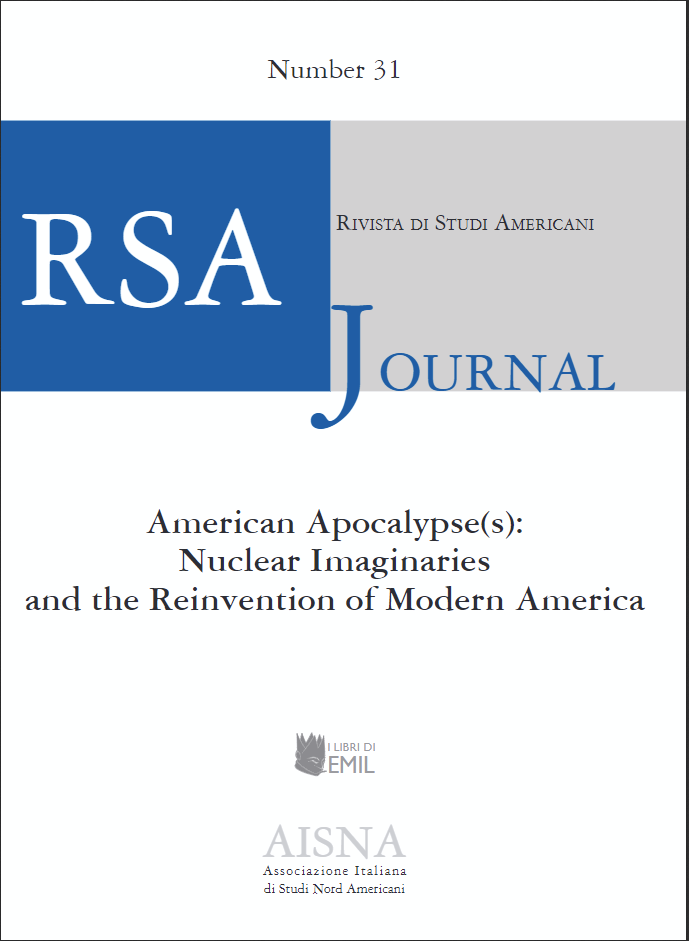Apocalyptic Allegories
Resisting Strategic Nuclear Imaginaries through Critical Literacy
DOI:
https://doi.org/10.13135/1592-4467/8496Parole chiave:
nuclear, apocalyptic, literacy, American nuclear cultureAbstract
Eschatological expressions underwent an epistemic shift with the Trinity tests on July 16, 1945 from an imaginative practice of predicting futurity to a cataclysmic vision of complete annihilation. Motifs of literacy, while seldom discussed, share a self-reflexive relation with nuclearization and cultural productions of the apocalypse, since the specialized nature of nuclear technology transforms nuclear discourses into signifiers of power: a form of cultural capital that emerges from and simultaneously legitimizes nuclear weapons. This intervention emphasizes how the epistemic violence of strategic nuclear imaginaries – employed through the constant anxiety of an anticipated nuclear catastrophe – can be countered through a critical literacy opposed to both martial ideologies as well as the instrumentalization of weaponized nuclear technology. Considering the current turbulence of an always already global nuclear landscape, this article examines two contemporary cinematic renderings of post-nuclear apocalyptic spaces, The Book of Eli (2010) and The Matrix (1999), to argue that any act of culturally representing/articulating the nuclear disaster is always an act of tangible recovery. In conclusion, I note that by uncovering the terrible realities of nuclear conflict and the dehumanization implicit in sophisticated techno-strategic paradigms, these artifacts from American nuclear culture, which are also coextensive with nuclear countercultures everywhere, show the emancipatory possibilities of humane community-oriented critical literacies.
##submission.downloads##
Pubblicato
Fascicolo
Sezione
Licenza
Avviso sul Copyright
RSAJournal applica una licenza CC BY-NC-ND a tutti i suoi contributi. Questa licenza consente agli utenti di copiare e distribuire il materiale in qualsiasi supporto o formato solo in forma non adattata, per scopi non commerciali e a condizione che venga esplicitato/a l'autore/autrice dell'opera. CC BY-NC-ND include i seguenti elementi:
- BY: L'autore deve essere riconosciuto come tale.
- NC: Sono consentiti solo utilizzi non commerciali dell'opera.
- ND: Non sono consentite opere derivate o adattamenti dell'opera.
Gli autori che pubblicano con questa rivista accettano i seguenti termini:
- Gli autori conservano il copyright e tutti i diritti di pubblicazione per i loro contributi alla rivista.
- Gli autori concedono alla rivista il diritto di prima pubblicazione in base alla licenza internazionale Creative Commons Attribution-NonCommercial-NoDerivatives 4.0, che consente ad altri di condividere l'opera non modificata per scopi non commerciali a condizione che venga esplicitato/a l'autore/autrice dell'opera e la sede di pubblicazione iniziale (questa rivista).
- Gli autori sono in grado di stipulare accordi contrattuali separati e aggiuntivi per la distribuzione non esclusiva della versione pubblicata dalla rivista (ad esempio, per inserirla in una repository istituzionale o pubblicarla in un libro), con l'indicazione che il contributo è stato precedentemente pubblicato in RSAJournal.




